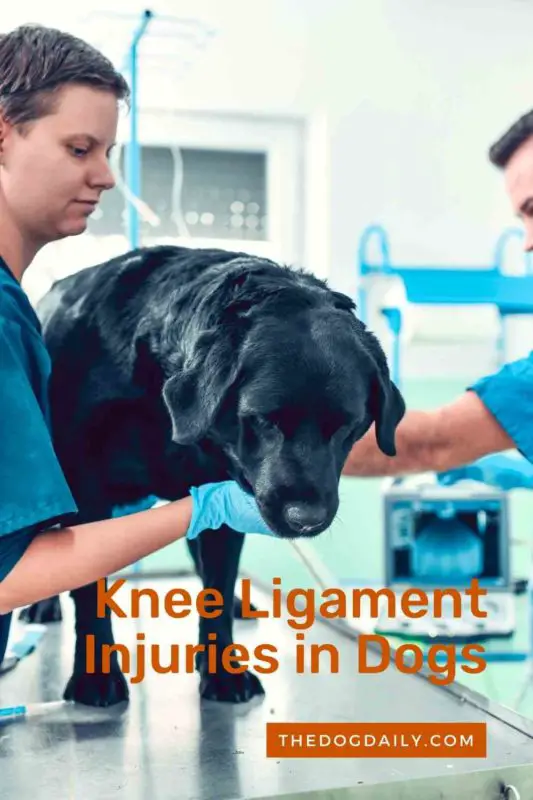Knee Injuries in Dogs
A year ago, when computer programmer Brad Kantor’s eight-year-old Golden Retriever, Goldy, began limping after their long morning walks, Kantor, who lives in Wayne, N.J., figured his once-lively puppy was getting older. When Goldy started dragging his back leg as he walked, though, his owner suspected there was something more going on than just the normal aging process. “I took him to the vet,” remembers Kantor. “She watched him walk and then felt around his bad knee. She suspected he would need surgery.”
Goldy is not alone. Each year, more than one million dogs develop hind leg problems due to what, as it turned out, Kantor’s dog had: a debilitating knee condition called a cranial cruciate ligament (or CCL) deficiency. While surgery is a painful fix, a new, less invasive procedure makes the operation easier on dogs. Below, Dr. James Cook, the University of Missouri-based veterinarian and orthopedic researcher who developed the procedure explains the injury and his innovative solution.
What is a CCL Injury in Dogs?
Human athletes often injure the knee’s anterior cruciate ligament (or ACL), and the CCL problem in dogs is comparable. ACL tears in humans result from one unfortunate accident, like a fall down the stairs or a twist on the basketball court. For dogs, CCL deficiencies are usually due to a degenerative process that develops over the years as athletic dogs leap to catch flying discs, tear around corners, and engage in other high-impact activities. “It’s the most common orthopedic injury in dogs,” says Dr. Cook. “It can occur in any breed at any age, though it’s most common in larger dogs like Newfoundlands, Goldens, Labradors and Rottweilers between the ages of two and nine.”
Preventing a CCL Injury in Dogs
While CCL deficiencies can’t always be avoided, the best way to stave them off is to keep your pet at a healthy weight. “Don’t let your dog get heavy, and keep the muscles around the knee strong with hiking, swimming and leash climbing,” advises Dr. Cook, who points out that the slender Greyhounds belong to the only large breed not afflicted with CCL problems. “You can’t strengthen the ligament, but you can strengthen the muscle around it.”
Dr. Cook also recommends that you make sure to feed your dog food with enough protein. According to the National Academy of Sciences, a minimum of 10 percent of your adult dog’s caloric intake should come from crude protein. “A quality commercial pet food does everything possible for a dog’s overall nutrition as well as the bones and joints. The science that goes into these products is incredible. It’s nice as a vet — we don’t have to formulate anything for dogs but can just advise our clients to feed the commercially available products.” Ask your veterinarian about the healthiest weight for your dog, and get recommendations for a weight reduction formula, if necessary.
Tightrope CCL Surgery
Small dogs that are overweight are sometimes treated conservatively with diet and exercise modifications. The best solution is usually surgery for the larger breeds, more prone to injury. Traditional methods involve cutting the bone, leading to complications — from bone fracture to joint damage. Dr. Cook’s technique, known as Tightrope CCL, relies on drilling and small incisions rather than cutting the bone. Because of the drilling, a dog must weigh at least 40 pounds to be a candidate for the Tightrope technique.
“The other surgeries work well, but I was drawn to switch to Tightrope because the complications are less serious,” Dr. Cook says. “When you cut the bone, and something goes wrong, the animal can be nonfunctional afterward, and it can be severe enough that the dog has to be put down.” He adds, “Also, the public is generally interested in less invasive techniques these days. So, that, too, was part of my consideration in developing this.”
Recovery From Knee Surgery
While the surgery is a cure, without rehabilitation, a dog will not heal. CCL surgeries like Tightrope require 10 to 12 weeks of limited post-op activity. “The dog should be walking short distances and only on a leash. It should be in a crate when you’re not around to monitor activity,” emphasizes Dr. Cook. “Don’t fall for that sad face and let your dog out!”
As the weeks of rehabilitation progress, your best friend will most likely experience a 95
percent return to full function. It will also be officially arthritic. At this point, Dr. Cook says, it becomes essential to attend to that condition, both with weight management .and feeding foods containing glucosamine and chondroitin sulfate, which are extracts from fish tissue and cartilage that are acknowledged building blocks for canine cartilage
As for Kantor’s dog, Goldy, he’s back in fine form after undergoing one of the older procedures to stabilize his knee. “I don’t throw things for him to jump for anymore,” says Kantor. “But we can still go for slow-paced walks before I go to work.” These are walks that both owner and dog now appreciate more than ever.
Article written by Author: Darcy Lockman

